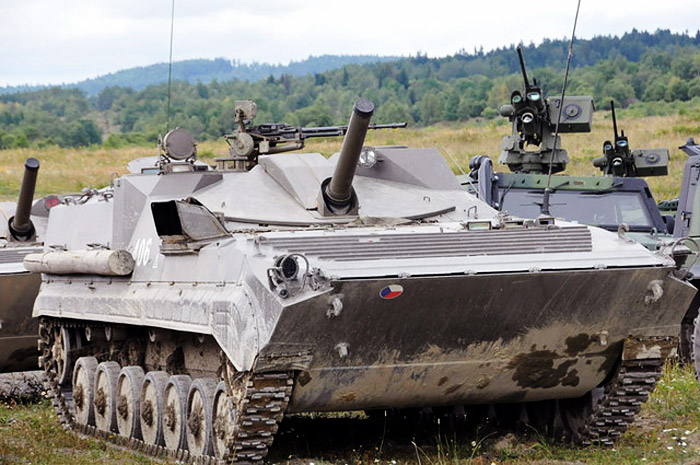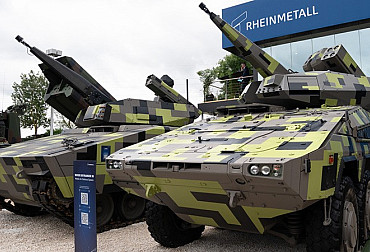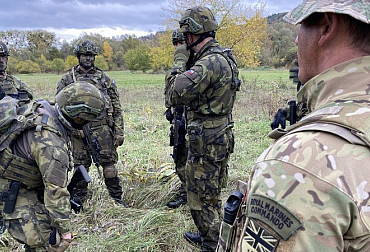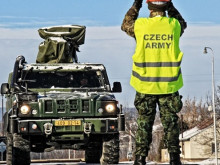Self-propelled mortars for batteries of mechanized battalions of the Czech Armed Forces – tracked chassis are possible, wheeled chassis are necessary
For the years 2023-2025, the Concept of build-up of the Czech Army 2030 envisages the acquisition of self-propelled mortars to increase the direct fire support capability of mechanised battalions and task groups in all types of operations. This is currently provided by mortar platoons armed with towed 120mm mortars of the Model 82 (PRAM-L), and only in the 72nd Mechanised Battalion only eight pieces of the then progressive but obsolete PRAM-S (Self-propelled).

Picture: 120mm self-propelled mortar PRAM-S | Ministry of Defence of the Czech Republic
This is one of many old debts to the Army – the original plan for the purchase of Pandur wheeled armoured vehicles also included a self-propelled mortar variant. Today we can say that it would be appropriate to acquire two systems: on a tracked platform for the 7th Brigade, and on a wheeled platform for the 4th Brigade. And of the two basic solution options then definitely choose the variant with the main weapon located in the turret. A major requirement will naturally be the significant participation of domestic industry in both the production and servicing of the vehicles and the supply of ammunition.
The document "Modernisation projects of the Czech Armed Forces" does not specify the type of chassis and requires parameters that can be met by both tracked and wheeled vehicles in terms of mobility (maximum speed on the road 70 km/h, in the terrain at least 40 km/h, range 400-500 km and air transportability – without more details). It assumes a 25-year life cycle and the acquisition of 62 units. This corresponds to the armament of five batteries + a small reserve (usable, for example, in Vyškov for training), with the current twelve mortars in the battery. The 41st, 42nd, 71st and 72nd Mechanised Battalions have their mortar batteries in their composition today. The original 74th Light Motorised Battalion has been transformed into a mechanised battalion and is due to be the first to receive the new tracked IFVs, and will probably also see the renewal of its mortar battery; similarly, however, the 44th Light Motorised Battalion will in the future receive the wheeled IFVs Pandur II 8x8, and with the transformation into a mechanised battalion it will need a mortar battery also.
The 2018 requirement of 62 pieces cannot be easily deciphered without defining the main armament arrangement. With the selection of the Swedish CV90 tracked Infantry Fighting Vehicles, it is quite automatic (but with a big caveat regarding direct fire) to acquire the Grkpbv 90 Mjölner type for the mortar batteries of the 7th Brigade, which features a double-barrelled arrangement and semi-automatic reloading, and is capable of a rate of fire of up to 16 rounds per minute. This would apparently make it sufficient, as with the Swedish mechanised battalions or their mortar batteries, to deploy eight vehicles (with a two-minute preparation time, they can shower the target with 128 rounds in the first minute and can change position); and with a lighter, single-barrel turret on a wheeled vehicle, the standard twelve (this would mean 24 tracked mortars for three batteries of 7. Brigade, and 36 vehicles for the batteries of the 4th Brigade + reserve; there can undoubtedly be more combinations, and there is talk of six vehicles in a battery).
 Picture: GRKPBV 90 | Felix Sundbäck / Försvarsmakten
Picture: GRKPBV 90 | Felix Sundbäck / Försvarsmakten
A certain disadvantage of the Mjölner system is the inability to conduct direct fire (the is 40-85° and the range 500-13000 m). On the other hand, the fact that the Czech company Ray Service is already involved in the production of mortars by supplying cable harnesses is an advantage. A more cost-effective solution is the Finnish-Swedish AMOS, also based on the CV90 platform, also a double-barrelled mortar, but capable of direct fire at a range of 150-1550 m, and its single-barrelled, cheaper and lighter variant NEMO, which can also be mounted well on wheeled chassis – a similar solution has been chosen for its vehicles, for example by the Polish Army (the M120 Rak system from Huta Stalowa Wola, SMG 120 tracked vehicles and SMK 120 wheeled vehicles).
The consideration of Swedish Mjölner tracked systems is conditioned by the success of the negotiations for the acquisition of the CV90 IFVs, on the grounds that a chassis of the same type would be an advantage in terms of operation and maintenance logistics. If large armies can afford to operate different tracked platforms, a few dozen of such a special purpose vehicle would be an unnecessary burden for the small Czech Army.
While it lacks logic to consider tracked self-propelled mortars in the 4th Brigade's line-up (the unit recently retired the last tracked vehicles from its armament), the alternative of using a single wheeled chassis for the batteries of the 7th Brigade's battalions remains possible not only in view of the fact that today the mortar batteries' armament is carried by wheeled Tatras. Leaving aside the not uninteresting possibility to develop such a variant on the platform of the new TITUS vehicles, the primary solution will probably rely on the more extended Pandur II 8x8 CZ chassis. In the past, Tatra Defence Vehicle has presented (most recently at last year's NATO Days in Ostrava-Mošnov) its solution for a self-propelled mortar with a Soltam Cardom main weapon mounted in the hull.
It is a widespread solution (e.g. in the form of the American M1129 Mortar Carrier on the STRYKER armoured vehicle platform), which has obvious advantages – especially simplicity, price and high firing cadence of 10-12 rounds per minute, and disadvantages – the protection of the operator is lower, even health risks for the operator during firing are mentioned, and especially the inability to fire directly. However, semi-direct and direct firing is required by the Czech Armed Forces, at least according to the parameters published in 2018.
 Picture: Patria AMV with NEMO mortar system (120 mm) | Patria
Picture: Patria AMV with NEMO mortar system (120 mm) | Patria
If the requirement of the ability to conduct direct fire prevails, practically the only solution is to equip the chosen wheeled (and possibly also tracked) platform with AMOS, NEMO or Polish RAK turrets. If the Army's preferences in this regard have evolved since 2018, a wider range of options is available.
 Picture: AMOS turret kit with double-barrel mortar | Patria
Picture: AMOS turret kit with double-barrel mortar | Patria
In any case, as with the RBS-70 and RBS-70NG anti-aircraft manpads, the makeshift in the form of towed PRAM-L mortars should end as soon as possible, and both our mechanised brigades should see a modern and effective solution in this area as well.





















